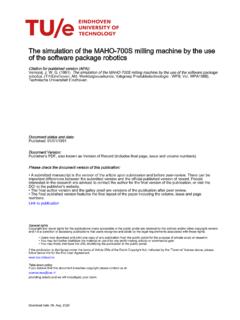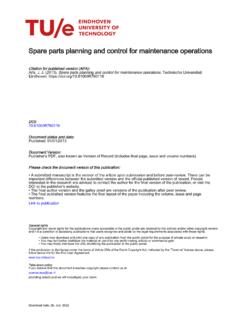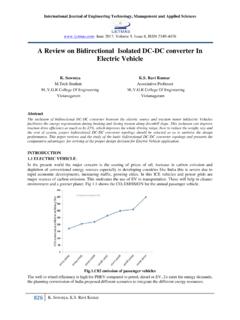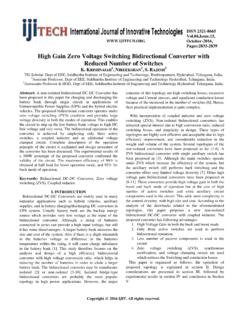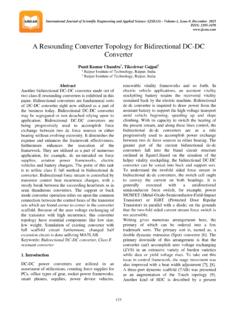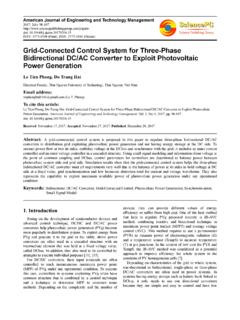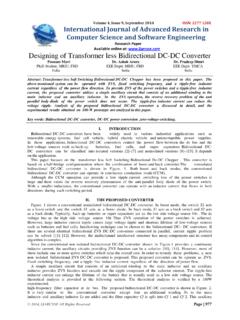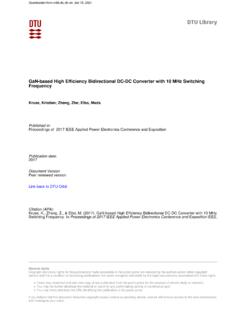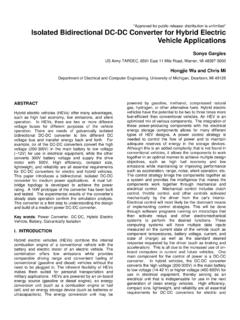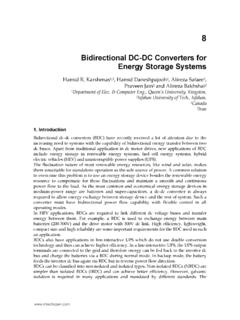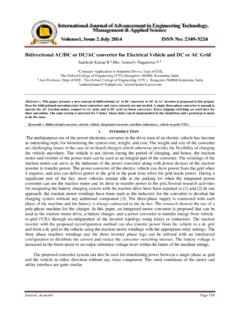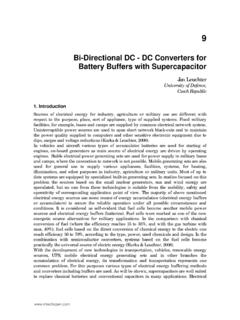Transcription of Family of multiport bidirectional DC-DC converters
1 Family of multiport bidirectional DC-DC convertersCitation for published version (APA):Tao, H., Kotsopoulos, A., Duarte, J. L., & Hendrix, M. A. M. (2006). Family of multiport bidirectional DC-DCconverters. IEE Proceedings - Electric Power Applications, 153(3), 451-458. :20050362 :20050362 Document status and date:Published: 01/01/2006 Document Version:Publisher s PDF, also known as Version of Record (includes final page, issue and volume numbers)Please check the document version of this publication: A submitted manuscript is the version of the article upon submission and before peer-review. There can beimportant differences between the submitted version and the official published version of record. Peopleinterested in the research are advised to contact the author for the final version of the publication, or visit theDOI to the publisher's website.
2 The final author version and the galley proof are versions of the publication after peer review. The final published version features the final layout of the paper including the volume, issue and to publicationGeneral rightsCopyright and moral rights for the publications made accessible in the public portal are retained by the authors and/or other copyright ownersand it is a condition of accessing publications that users recognise and abide by the legal requirements associated with these rights. Users may download and print one copy of any publication from the public portal for the purpose of private study or research. You may not further distribute the material or use it for any profit-making activity or commercial gain You may freely distribute the URL identifying the publication in the public the publication is distributed under the terms of Article 25fa of the Dutch Copyright Act, indicated by the Taverne license above, pleasefollow below link for the End User down policyIf you believe that this document breaches copyright please contact us details and we will investigate your date: 03.
3 Apr. 2021 Family of multiport bidirectional DC DC convertersH. Tao, A. Kotsopoulos, Duarte and HendrixAbstract: multiport DC DC converters are of potential interest in applications such as generationsystems utilising multiple sustainable energy sources. A Family of multiport bidirectional DC DCconverters derived from a general topology is presented. The topology shows a combination ofDC-link and magnetic coupling. This structure makes use of both methods to interconnect multiplesources without the penalty of extra conversion or additional switches. The resulting convertershave the advantage of being simple in topology and have a minimum number of power proposed general topology and basic cells showseveral possibilities toconstruct a multiportconverter for particular applications and provide a solution to integrate diverse sources owing totheir flexibility in structure.
4 The system features a minimal number of conversion steps, low costand compact packaging. In addition, the control and power management of the converter by asingle digital processor is possible. The centralised control eliminates complicated communicationstructures that would be necessary in the conventional structure based on separate conversionstages. A control strategy based on classical control theory is proposed, showing a multiple PID-loop structure. The general topology and a set of three-port embodiments are IntroductionRecent developments in sustainable energy sources such asfuel cells and photovoltaics (PV ) have brought challengesto the design of power conversion systems. Future powersystems will require interfacing of various energy enable multi-source technology, a multi-input powerconverter is of practical use.
5 An ideal multi-input powersupply could accommodate a variety of sources andcombine their advantages. With multiple inputs, the energysource is diversified to increase reliability and utilisation ofsustainable , there are two structures suitable for such asystem. In the conventional structure, shown in Fig. 1, tointerconnect multiple sources, there usually exists acommon high-voltage or low-voltage DC bus. SeparateDC DC conversion stages are employed for individualsources. These converters are linked together at the DC busand controlled independently. In some systems, a commu-nication bus may be included to exchange information andmanage power flow between the sources. A number of so-called front-end DC DC converters , such as the interleavedboost converter [1], the current-fed push pull converter [2],the phase-shifted full-bridge converter [3], the three-phaseconverter[4]etc.
6 , have been developed to interface papers also contribute to the design of bidirectionalconverters to connect storage[5 7]. However, a drawbackof this structure lies in the fact that it is inherently complexand has a high cost due to the multiple conversion stagesand communication devices between individual shown in Fig. 2, this paper proposes a multiportstructure. Compared to the conventional one, in thisstructure the whole system is treated as a single powerconverter, which combines multiple sources. The regulationof outputs and management of source powers can becarried out by a powerful controller, such as a digital signalprocessor (DSP). The need for a multiport DC DCconverter is attracting research interest. The multi-inputtopologies for combining diverse sources found in theliterature are eithernon-isolated direct link[8 11]ormagnetic coupling[12 14].
7 The methods to combinemultiple sources presented in these papers include puttingsources in series[8], paralleling sources via a DC bus[9],using flux additivity by a multi-winding transformer[12],orthe time-sharing concept[14]. However, these existing multi-input converters are either unidirectional or only for low-power applications. Based ona general topology using acombination of a DC-link and magnetic coupling, a newfamily of multiport bidirectional DC DC converters ispresented in this paper. The resulting converters presentpromising features such as simple topology and low power generation systems utilising multiple sustain-able sources, the system is also of potential interest inapplications that have a multiport structure or multiplevoltage buses, such as uninterrupted power supplies (UPS),multi-voltage-bus electrical vehicles, systems with multipleregulated outputs cellbatterywind turbinephotovoltaicDC busAC busACloadFig.
8 1 Conventional structureE-mail: authors are with the Electromechanics and Power Electronics Group,Department of Electrical Engineering, Eindhoven University of Technology5600 MB Eindhoven, The NetherlandsrThe Institution of Engineering and Technology 2006 IEE Proceedingsonline no. 20050362 :20050362 Paper first received 1st September and in final revised form 28th November 2005 IEE Power Appl., Vol. 153, No. 3, May 2006451 Authorized licensed use limited to: Eindhoven University of Technology. Downloaded on October 23, 2009 at 10:11 from IEEE Xplore. Restrictions apply. 2 Novel multiport bidirectional multiport against conventionalstructureTo satisfy the applications where an energy storage elementis indispensable, at least one port that connects the storagesshould be bidirectional .
9 In general, all portsare consideredto be bidirectional . Therefore,it is not essential to explicitlydistinguish inputs (sources) oroutputs (loads). Accordingly,the converter presented in this paper is called a multiportconverter instead of a multi-input or multi-output con-verter. To this extent, loads and storages can be viewed assources as well. This convention is adhered to in this , the multiport structure has an advantage overthe conventional structure in terms of the number of powerdevices and conversion steps used because the systemresources ( conversion devices) are shared. As a result,the system efficiency can be improved. Table 1 gives acomparison of the two structures. The multiport structure ispromising from the viewpoints of low cost, centralisedcontrol and compact packaging.
10 However, a multiportconverter is complex and therearemoredesignchallenges, the control Novel multiport bidirectional topologyConceptually, both the DC-link and magnetic-couplingapproaches allow bidirectional power flow and canincorporate diverse sources[15]. The DC-link is a methodin which a number of differentsources are linked togetherthrough switching cells to a DC bus where energy isbuffered by means of capacitors. Current-mode or voltage-mode control may be applied to regulate input currents andthe DC-link voltage. However, the DC-link cannot handle awide variety of source voltages. Therefore, the operatingvoltages of different sourcesshould be close to avoid largebuck/boost conversion ratios. On the other hand, with themagnetic-coupling method, sources are interconnectedthrough a multi-winding transformer.


